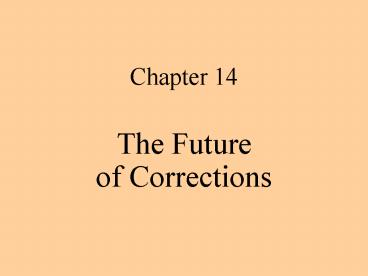The Future of Corrections - PowerPoint PPT Presentation
1 / 15
Title:
The Future of Corrections
Description:
Chapter 14 The Future of Corrections The Future of Corrections Collateral Effects of Imprisonment Politics of Corrections and the Media The War on Drugs The Costs of ... – PowerPoint PPT presentation
Number of Views:186
Avg rating:3.0/5.0
Title: The Future of Corrections
1
Chapter 14
- The Futureof Corrections
2
The Future of Corrections
- Collateral Effects of Imprisonment
- Politics of Corrections and the Media
- The War on Drugs
- The Costs of Current Policies
- Changes in the Justice System
- New Technologies
- New Models of the Correctional Mission
3
Collateral Costs of Imprisonment
- 400 increase in imprisonment since 1980
- Harm to families and communities
- Disenfranchisement
- Risk of disease
- Crime and prison rates largely unrelated
- 25 decline in violent crime
- Increasing recidivism and severity of crime
4
Media
- Agenda Setting Directs concern to particular
issues, opinions on topic set by personal factors - Also creates images that are widely accepted
- Corrections issues manipulated for political and
monetary gains by politicians, victims groups,
CO unions, and prison-industrial complex - Simple, dramatic, unusual stories preferred
- Correctional successes avoid publicity
5
Media (continued)
- 1990-1998, homicide rates dropped 50 but media
news coverage increased 400 - Reporters poorly informed about corrections
- Correctional officials reluctant to deal with
media, give impression of secrecy
6
War on Drugs
- Alcohol the most criminogenic drug
- 453,000 imprisoned for drugs at annual cost of 5
billion - 58 have no violent history
- One in three female inmates is a drug offender
- Disproportionate minority confinement largely due
to severe drug penalties
7
Drugs (continued)
- Violent offenders receiving early parole to
create space for drug offenders with mandatory
sentences - Punishment ineffective with compulsive behaviors
such as drug addiction - Allocation of treatment resources very uneven,
biased
8
Costs of Current Policies
- 690 of every 100,000 citizens incarcerated
- 7 of all state resources committed to prisons
- Average annual cost for minimum security male
prisoner is 25,000 - Reintegration programs cut to pay for operating
costs of new prisons - Harshness linked to recidivism
9
System Changes
- Courts greatly have broadened police powers in
last 20 years - Prosecutors discretion increasing, judicial
discretion declining - Increased victims rights can facilitate
harshness or reintegration - Victim Impact Statements common
- Mediation used in a few areas
10
New Technologies
- Computerized information sharing between
agencies, jurisdictions - Biometrics Recognition via fingerprints,
voiceprints, or eye, hand, face shape - Smart cards Hold biometrics, medial, legal,
other data - Victim updates on case, offender status
computerized
11
Technologies (continued)
- Online medical care, education, training
- Defense equipment used in corrections
- Ground penetrating radar, puncture resistant
clothes, heartbeat sensors - DNA and similar forms of evidence
- Better, cheaper offender tracking, record
storage/transfer greater efficiency
12
The Correctional Mission
- Community corrections the main area for major
changes - Fears of discrimination and financial costs
increasingly suggest need for new approaches - Growing desire to give communities more autonomy
in responding to crime
13
Restorative Justice
- Three simultaneous goals
- Assist victim
- Prevent future crime
- Reintegrate offender
- Acknowledges failure of punishment to alter
behavior - Focuses on assuring a better future for all
14
Community Justice
- Integrates corrections with area C.J agencies on
formal and informal bases - Also includes educational, welfare, health,
housing, transportation etc, systems - Broken Windows Approach Potentially criminogenic
situations are referred to appropriate agency
BEFORE they get worse - Most efforts experimental, places power mainly in
hands of line practitioners - Resisted by hierarchical traditions of
corrections/C.J.
15
Accreditation
- American Correctional Association (ACA)
- Sets standards that guide the policies and
practices of many agencies - Dozens of manuals set all sorts of standards for
all types of agencies - These standards often referred to by courts
evaluating conditions and practices - Accreditation is not a formal defense































